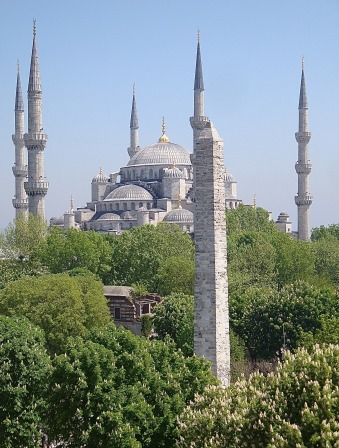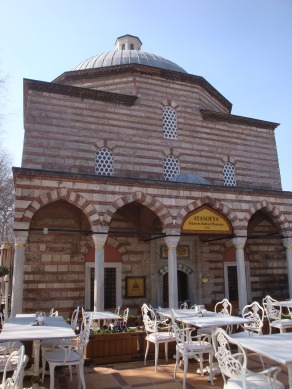For visitors to İstanbul all paths lead to Sultanahmet, the ancient heart of the city where first the Byzantines and then the Ottomans built their palaces on a dramatic bluff overlooking the confluence of the Bosphorus and the Golden Horn.. This is where all the big-ticket tourist attractions are to be found, handily grouped together within walking distance of each other. Uou’ll need two or three days to do justice to them – Topkapı Sarayı (Topkapı Palace) alone could take up the best part of a day if you want to see everything without rushing.
The area takes its name from the huge Sultanahmet Cami, better known to visitors as the Blue Mosque. Across a small park with a large fountain, this faces the equally enormous Ayasofya which started life as the Byzantine church of Hagia Sophia, became a mosque after the conquest of Constantinople in 1453, became a museum in 1935 and then reverted to being a mosque again in 2020. Sultanahmet Cami/Blue Mosque from Hippdodrome
Sultanahmet Cami/Blue Mosque from Hippdodrome
Behind Ayasofya is the wonderful Topkapı Sarayı (Topkapı Palace), a world within a world of dainty Ottoman kiosks and stone apartments grouped around serene gardens where the Ottoman sultans lived and originally conducted their business.
Just across the tramline from the main square is the atmospheric Yerebatan Sarnıcı (Basilica Cistern).
The Blue Mosque/Sultanahmet Cami is sandwiched between the historic Hippodrome where chariot races were held in Byzantine times and the picturesque Arasta Bazaar with some delightful little shops. Hidden in the midst of the bazaar is the Great Palace Mosaics Museum, the most striking survival from the Byzantine Great Palace. In 2024 it was closed for restoration.
One of İstanbul’s finest hamams (Turkish baths), the Ayasofya Hürrem Sultan Hamamı, is in Ayasofya Meydanı in Sultanahmet, while two others (Cağaloğlu and Çemberlitaş) are within easy walking distance. There’s even a fine – and sometimes overlooked – park (Gülhane) that was once part of the Topkapı Palace complex and now makes a great place to take a break from the sightseeing.
 Ayasofya Hürrem Sultan HamamıTo get to Gülhane from Sultanahmet without following the tramlines you could instead take the steep cobbled street that runs down from beside the back of Ayasofya to the park entrance. Söğükçeşme Sokağı was once a dejected street of crumbling wooden buildings until it was taken under his wing by Çelik Gülersoy (1930-2003), the man who began restoring the Ottoman buildings long before it was fashionable to do so. Today the pretty pastel-coloured houses form the Ayasofya Mansions (Ayasofya Konakları), one of the city’s most romantic places to stay, with the grounds of Topkapı immediately behind it and Ayasofya immediately in front. Here, too, is the atmospheric Sarnıç Restaurant housed in one of the many Byzantine cisterns dotted about the city.
Ayasofya Hürrem Sultan HamamıTo get to Gülhane from Sultanahmet without following the tramlines you could instead take the steep cobbled street that runs down from beside the back of Ayasofya to the park entrance. Söğükçeşme Sokağı was once a dejected street of crumbling wooden buildings until it was taken under his wing by Çelik Gülersoy (1930-2003), the man who began restoring the Ottoman buildings long before it was fashionable to do so. Today the pretty pastel-coloured houses form the Ayasofya Mansions (Ayasofya Konakları), one of the city’s most romantic places to stay, with the grounds of Topkapı immediately behind it and Ayasofya immediately in front. Here, too, is the atmospheric Sarnıç Restaurant housed in one of the many Byzantine cisterns dotted about the city.
Eating
Matbah. Tel: 0212-514 6151
Sarnıç Restaurant. Tel: 0212-512 4291
Seasons Restaurant. Tel: 0212-402 3000
 Sleeping
Sleeping
Sultanahmet (or, more accurately, adjacent Cankurtaran) is home to some of the city’s finest boutique hotels as well as many more run-of-the-mill places to stay. There are even several hostels here for those on tight budgets.
Proximity to the main sights means that if you stay in Sultanahmet you can easily pop back to your room between attractions for a quick rest, something that is especially desirable in high summer when the heat and the crowds can be wearing.
Ayasofya Mansions (Ayasofya Konakları). Tel: 0212-513 3660
Hotel Yeşil Ev. Tel: 0212-517 6785
İstanbul Old City Ayasofya Hotel

Transport info
Sultanahmet is connected by the tram to Sirkeci and Eminönü for ferry services around the city, and to Beyazıt for the Grand Bazaar (Kapalı Çarşı).
You can easily get from here to the main bus station at Esenler (Otogar) one change from the tram to the Metro at Aksaray.
Nearby areas
Read about a difficult time in Sultanahmet: SILENCE FALLS ON SULTANAHMET

Sultan Ahmed III Çeşmesi in front of Topkapı Palace gate


